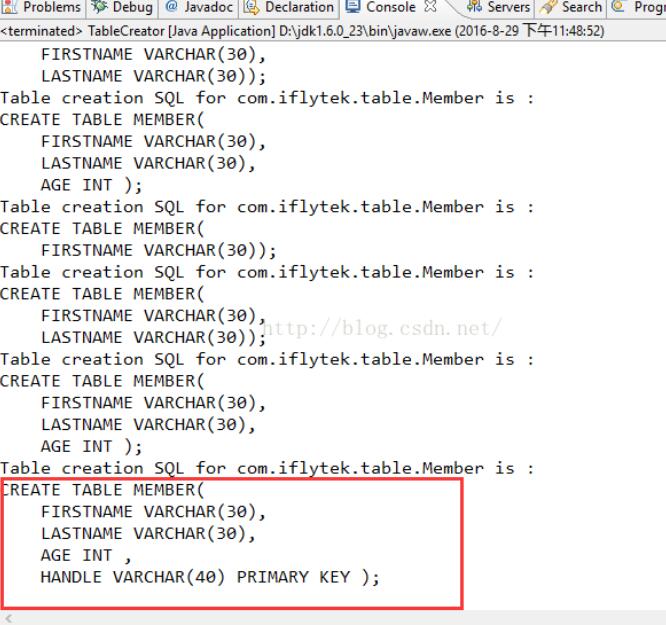用注解編寫創立表的SQL語句。本站提示廣大學習愛好者:(用注解編寫創立表的SQL語句)文章只能為提供參考,不一定能成為您想要的結果。以下是用注解編寫創立表的SQL語句正文
本文實例講述了SQL Server完成將特定字符串拆分並停止拔出操作的辦法。分享給年夜家供年夜家參考,詳細以下:
--輪回履行添加操作
declare @idx as int
While Len(@UserList) > 0
Begin
Set @idx = Charindex(',', @UserList);
--只要一條數據
If @idx = 0 and Len(@UserList) > 0
Begin
Insert Into BIS_MsgCenterInfo(ID,MsgID,UserID,[State])Values(Newid(),@ID,@UserList,0);
Break;
End
--多條數據
If @idx > 1
Begin
Insert Into BIS_MsgCenterInfo(ID,MsgID,UserID,[State]) Values(Newid(),@ID,left(@UserList, @idx - 1),0);
Set @UserList = right(@UserList, Len(@UserList) - @idx);
End
Else
Set @UserList = right(@UserList, Len(@UserList) - @idx);
End
願望本文所述對年夜家SQL Server數據庫法式設計有所贊助。
ges、types(類、接口、列舉、Annotation類型)、類型成員(辦法、結構辦法、成員變量、列舉值)、辦法參數和當地變量(如輪回變量、catch參數)。在Annotation類型的聲明中應用了target可加倍了了其潤飾的目的。 感化:用於描寫注解的應用規模(即:被描寫的注解可以用在甚麼處所) 取值(ElementType)有: 1.CONSTRUCTOR:用於描寫結構器 2.FIELD:用於描寫域 3.LOCAL_VARIABLE:用於描寫部分變量 4.METHOD:用於描寫辦法 5.PACKAGE:用於描寫包 6.PARAMETER:用於描寫參數 7.TYPE:用於描寫類、接口(包含注解類型) 或enum聲明 @Retention: @Retention界說了該Annotation被保存的時光長短:某些Annotation僅湧現在源代碼中,而被編譯器拋棄;而另外一些卻被編譯在class文件中;編譯在class文件中的Annotation能夠會被虛擬機疏忽,而另外一些在class被裝載時將被讀取(請留意其實不影響class的履行,由於Annotation與class在應用上是被分別的)。應用這個meta-Annotation可以對 Annotation的“性命周期”限制。 感化:表現須要在甚麼級別保留該正文信息,用於描寫注解的性命周期(即:被描寫的注解在甚麼規模內有用) 取值(RetentionPoicy)有: 1.SOURCE:在源文件中有用(即源文件保存) 2.CLASS:在class文件中有用(即class保存) 3.RUNTIME:在運轉時有用(即運轉時保存) Retention meta-annotation類型有獨一的value作為成員,它的取值來自java.lang.annotation.RetentionPolicy的列舉類型值 */ @Target(ElementType.TYPE) @Retention(RetentionPolicy.RUNTIME) public @interface DBTable { public String name() default ""; }Constraints 束縛注解:
/** * Project Name:myannotation * File Name:Constraints.java * Package Name:com.iflytek.db * Date:2016-8-28下晝08:27:08 * Copyright (c) 2016, [email protected] All Rights Reserved. * */ package com.iflytek.db; import java.lang.annotation.ElementType; import java.lang.annotation.Retention; import java.lang.annotation.RetentionPolicy; import java.lang.annotation.Target; @Target(ElementType.FIELD) @Retention(RetentionPolicy.RUNTIME) public @interface Constraints { boolean primaryKey() default false; boolean allowNull() default true; boolean unique() default false; }
SQLInteger int注解:
/** * Project Name:myannotation * File Name:SQLInteger.java * Package Name:com.iflytek.db * Date:2016-8-29下晝10:24:11 * Copyright (c) 2016, [email protected] All Rights Reserved. * */ package com.iflytek.db; import java.lang.annotation.ElementType; import java.lang.annotation.Retention; import java.lang.annotation.RetentionPolicy; import java.lang.annotation.Target; @Target(ElementType.FIELD) @Retention(RetentionPolicy.RUNTIME) public @interface SQLInteger { String name() default ""; Constraints constraints() default @Constraints; }
SQLString 字符注解:
/** * Project Name:myannotation * File Name:SQLString.java * Package Name:com.iflytek.db * Date:2016-8-29下晝10:28:04 * Copyright (c) 2016, [email protected] All Rights Reserved. * */ package com.iflytek.db; import java.lang.annotation.ElementType; import java.lang.annotation.Retention; import java.lang.annotation.RetentionPolicy; import java.lang.annotation.Target; @Target(ElementType.FIELD) @Retention(RetentionPolicy.RUNTIME) public @interface SQLString { int value() default 0; String name() default ""; Constraints constraints() default @Constraints; }
創立表的處置器:
/** * Project Name:myannotation * File Name:TableCreator.java * Package Name:com.iflytek.table * Date:2016-8-29下晝10:57:52 * Copyright (c) 2016, [email protected] All Rights Reserved. * */ package com.iflytek.table; import java.lang.annotation.Annotation; import java.lang.reflect.Field; import java.util.ArrayList; import java.util.List; import com.iflytek.db.Constraints; import com.iflytek.db.DBTable; import com.iflytek.db.SQLInteger; import com.iflytek.db.SQLString; public class TableCreator { public static void main(String[] args) { createTable(Member.class); } //創立表SQL語句 private static void createTable(Class<?> cl) { //獲得DBTable注解 DBTable dbTable = cl.getAnnotation(DBTable.class); //斷定DBTable注解能否存在 if (dbTable == null) { System.out.println("沒有找到關於DBTable"); return; } //假如@DBTable注解存在獲得注解 String tableName = dbTable.name(); //斷定表名能否存在 if (tableName.length() < 1) { //不存在,解釋默許就是類名,經由過程 cl.getSimpleName()獲得類名而且年夜寫 tableName = cl.getSimpleName().toUpperCase(); } //界說獲得column的容器 List<String> columnDefs = new ArrayList<String>(); //輪回屬性字段 //解釋:getDeclaredFields()取得某個類的一切聲名的字段,即包含public、private和proteced,然則不包含父類的聲名字段。 //getFields()取得某個類的一切的公共(public)的字段,包含父類。 for (Field field : cl.getDeclaredFields()) { //界說表字段稱號變量 String columnName = null; //獲得字段上的注解(如今字段許可多個注解,是以前往的是數組) Annotation[] anns = field.getDeclaredAnnotations(); //斷定屬性能否存在注解 if (anns.length < 1) continue; //斷定能否是我們界說的數據類型 if (anns[0] instanceof SQLInteger) { //獲得SQLInteger 注解 SQLInteger sInt = (SQLInteger)anns[0]; //斷定能否注解的name能否有值 if (sInt.name().length() < 1) { //假如沒有值,解釋是類的屬性字段,獲得屬性並轉換年夜寫 columnName = field.getName().toUpperCase(); } else { //假如有值,獲得設置的name值 columnName = sInt.name(); } //放到屬性的容器內 columnDefs.add(columnName + " INT " + getConstraints(sInt.constraints())); } //同上SQLInteger,這裡不寫正文了 if (anns[0] instanceof SQLString) { SQLString sString = (SQLString)anns[0]; if (sString.name().length() < 1) { columnName = field.getName().toUpperCase(); } else { columnName = sString.name(); } columnDefs.add(columnName + " VARCHAR(" + sString.value() + ")" + getConstraints(sString.constraints())); } //界說生成創立表的SQL語句 StringBuilder createCommand = new StringBuilder("CREATE TABLE " + tableName + "("); //輪回下面屬性容器, for (String columnDef : columnDefs) { //把屬性添加到sql語句中 createCommand.append("\n " + columnDef + ","); //去失落最初一個逗號 String tableCreate = createCommand.substring(0, createCommand.length() - 1) + ");"; //打印 System.out.println("Table creation SQL for " + cl.getName() + " is :\n" + tableCreate); } } } private static String getConstraints(Constraints con) { String constraints = ""; //斷定能否為null if (!con.allowNull()) { constraints += " NOT NULL "; } //斷定能否是主鍵 if (con.primaryKey()) { constraints += " PRIMARY KEY "; } //能否獨一 if (con.unique()) { constraints += " UNIQUE "; } return constraints; } }
以上代碼拷貝出來,便可以運轉了!
下面固然是簡略的創立表語句,但我們可以舒展到hibernate的domain類裡的注解,各類CURD ,未嘗不是如許處置的呢,只是hibernate有許多器械,然則萬變不離其宗,今後無機會研討一下hibernate 。
收成:
讀了今後,關於注解曉得為何要這麼用了,其實望文生義就是一個注解,只是有一個處置器來處置這個注解,這對我今後用到注解方面應當有贊助的,
時光不早了,就寫到這裡!
成果:

以上就是本文的全體內容,願望對年夜家的進修有所贊助,也願望年夜家多多支撐。